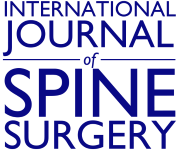Abstract
Background More sophisticated surgical techniques for correcting adult spinal deformity (ASD) have increased operative times, adding to physiologic stress on patients and increased complication incidence. This study aims to determine factors associated with operative time using a statistical learning algorithm.
Methods Retrospective review of a prospective multicenter database containing 837 patients undergoing long spinal fusions for ASD. Conditional inference decision trees identified factors associated with skin-to-skin operative time and cutoff points at which factors have a global effect. A conditional variable-importance table was constructed based on a nonreplacement sampling set of 2000 conditional inference trees. Means comparison for the top 15 variables at their respective significant cutoffs indicated effect sizes.
Results Included: 544 surgical ASD patients (mean age: 58.0 years; fusion length 11.3 levels; operative time: 378 minutes). The strongest predictor for operative time was institution/surgeon. Center/surgeons, grouped by decision tree hierarchy, a and b were, on average, 2 hours faster than center/surgeons c-f, who were 43 minutes faster than centers g-j, all P < 0.001. The next most important predictors were, in order, approach (combined vs posterior increases time by 139 minutes, P < 0.001), levels fused (<4 vs 5–9 increased time by 68 minutes, P < 0.050; 5–9 vs < 10 increased time by 47 minutes, P < 0.001), age (age <50 years increases time by 57 minutes, P < 0.001), and patient frailty (score <1.54 increases time by 65 minutes, P < 0.001). Surgical techniques, such as three-column osteotomies (35 minutes), interbody device (45 minutes), and decompression (48 minutes), also increased operative time. Both minor and major complications correlated with <66 minutes of increased operative time. Increased operative time also correlated with increased hospital length of stay (LOS), increased estimated intraoperative blood loss (EBL), and inferior 2-year Oswestry Disability Index (ODI) scores.
Conclusions Procedure location and specific surgeon are the most important factors determining operative time, accounting for operative time increases <2 hours. Surgical approach and number of levels fused were also associated with longer operative times, respectively. Extended operative time correlated with longer LOS, higher EBL, and inferior 2-y ODI outcomes.
Clinical Relevance We further identified the poor outcomes associated with extended operative time during surgical correction of ASD, and attributed the useful predictors of time spent in the operating room, including site, surgeon, surgical approach, and the number of levels fused.
Level of Evidence 3.
Footnotes
Funding The International Spine Study Group (ISSG) is funded through research grants from DePuy Synthes, and those grants supported the current study.
Declaration of Conflicting Interests The International Spine Study Group (ISSG) is funded through research grants from DePuy Synthes, and supported the current work. Portions of this work were accepted for podium presentation at the North American Spine Society Conference, Orlando, Florida, United States, October 27, 2017.
Disclosures Conflicts of Interest outside submitted work: Peter G. Passias reports serving as a consultant to Zimmer Biomet, Medicrea, and Spinewave. Gregory Mundis reports consulting, royalties, research funding (not paid to Dr. Mundis) from Nuvasive; consulting and royalties from K2M; honorarium from DePuy Synthes; and research funding (not paid to Dr. Mundis) from DePuy Synthes/ISSG. Doug Burton reports consultant, royalties, and research support from DePuy Synthes. Robert Eastlack reports personal fees from Globus Medical, NuTech, Nuvasive, Alphatec, DiFusion,Top Doctors, Nocimed, K2M, Titan, Seaspine, Atlas, Invuity, Nutech, Stryker, Carevature, Ulrich, AOspine, Eli Lilly, and UCSF; grants and personal fees from Nuvasive; personal fees and other from Spine Innovations, Aesculap, and Depuy Synthes; other from San Diego Spine Foundation, InjureFree, Nocimed, and SOLAS; and grants from Integra outside the submitted work. Robert Hart reports personal fees from Globus, Seaspine, and DePuy Synthes; grants from Medtronic; board member for CSRS and ISSLS; executive committee for ISSG; and a patent from OHSU. Frank Schwab reports grants from SRS and DePuy Spine (through ISSGF); speaking/teaching arrangements and consulting from Zimmer-Biomet, NuVasive, K2M, MSD, and Medicrea; Board of Directors and shareholder for Nemaris INC; and royalties from K2M and MSD. Virginie LaFage reports paid lectures from Depuy Synthes, Nuvasive, K2M, and Medtronic; and board member and shareholder for Nemaris. Chris Shaffrey reports royalties, patents, and consulting from Medtronic and Zimmer; royalties, patents, consultant, and stock holder from Nuvasive; consulting for K2M, Stryker, and In Vivo; grants from NIH, Department of Defense, ISSG, DePuy Synthes, and AO. Daniel Sciubba reports consulting for Medtronic. Shay Bess reports consulting, royalties, research support for K2 Medical; consulting for Allosource; royalties from Pioneer; royalties and research support from Innovasis and Nuvasive; and research support from DePuy Synthes Spine and Stryker. Chris Ames reports consulting for DePuy Synthes, Medtronic, and Stryker; royalties from Zimmer Biomet; and patents with Fish & Richardson, PC. Eric Klineberg reports consulting for DePuy Synthes and Stryker; paid speaker for AOSpine and K2M; and fellowship support from K2M. The remaining authors have no disclosures.
Ethics approval Each institution obtained approval from their local Institutional Review Board to enroll patients in the prospective database. A statement of the location: Work was performed at NYU Langone Medical Center-Orthopaedic Hospital, New York, NY, USA
- This manuscript is generously published free of charge by ISASS, the International Society for the Advancement of Spine Surgery. Copyright © 2022 ISASS. To see more or order reprints or permissions, see http://ijssurgery.com.






